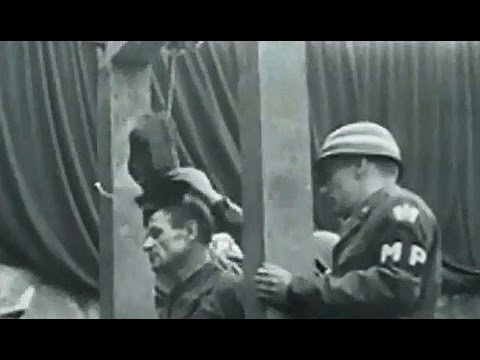War Criminals: “Guilty Men” 1945 Army-Navy Screen Magazine #79 World War II Nuremburg Trials
more at
NEW VERSION with improved video & sound:
Public domain film from the National Archives, slightly cropped to remove uneven edges, with the aspect ratio corrected, and mild video noise reduction applied.
The soundtrack was also processed with volume normalization, noise reduction, clipping reduction, and/or equalization (the resulting sound, though not perfect, is far less noisy than the original).
The Nuremberg Trials were a series of military tribunals, held by the Allied forces of World War II, most notable for the prosecution of prominent members of the political, military, and economic leadership of the Nazi Germany. The trials were held in the city of Nuremberg, Bavaria, Germany, in 1945–46, at the Palace of Justice.
The first and best known of these trials, described as “[t]he greatest trial in history” by Norman Birkett, one of the British judges who presided over it, was the Trial of the Major War Criminals before the International Military Tribunal (IMT). Held between 20 November 1945 and 1 October 1946, the Tribunal was given the task of trying 23 of the most important political and military leaders of the Third Reich, though one of the defendants, Martin Bormann, was tried in absentia, while another, Robert Ley, committed suicide within a week of the trial’s commencement. Absent from the 23 were Adolf Hitler, Heinrich Himmler, and Joseph Goebbels, all of whom had committed suicide several months before the indictment was signed.
The second set of trials of lesser war criminals was conducted under Control Council Law No. 10 at the US Nuremberg Military Tribunals (NMT); among them included the Doctors’ Trial and the Judges’ Trial. This article primarily deals with the IMT; see the Subsequent Nuremberg Trials for details on those trials…
Participants
Each of the four countries provided one judge and an alternate, as well as a prosecutor…
Defense Counsel
The majority of defense attorneys were German lawyers. These included Georg Fröschmann, Heinz Fritz (Hans Fritzsche), Otto Pannenbecker (Wilhelm Frick), Alfred Thoma (Alfred Rosenberg), Kurt Kauffmann (Ernst Kaltenbrunner), Hans Laternser (general staff and high command), Franz Exner (Alfred Jodl), Alfred Seidl (Hans Frank), Otto Stahmer (Hermann Göring), Walter Ballas (Gustav Krupp von Bohlen und Halbach), Hans Flächsner (Albert Speer), Günther von Rohrscheidt (Rudolf Heß), Egon Kubuschok (Franz von Papen), Robert Servatius (Fritz Sauckel), Fritz Sauter (Joachim von Ribbentrop), Walther Funk (Baldur von Schirach), Hanns Marx (Julius Streicher), Otto Nelte and Herbert Kraus. The main counsels were supported by a total of 70 assistants, clerks and lawyers…
The International Military Tribunal was opened on October 20, 1945, in the Palace of Justice in Nuremberg…
The accusers were successful in unveiling the background of developments that had led to the outbreak of World War II, which cost at least 40 million lives in Europe alone, as well as the extent of the atrocities committed in the name of the Hitler regime. Twelve of the accused were sentenced to death, seven received prison sentences, and three were acquitted.
The death sentences were carried out 16 October 1946 by hanging using the standard drop method instead of long drop. The U.S. army denied claims that the drop length was too short which caused the condemned to die slowly from strangulation instead of quickly from a broken neck. But evidence remains that some of the condemned men died agonizingly slowly taking from between 14 minutes to choke to death to as longs as struggling for 28 minutes. The executioner was John C. Woods. The executions took place in the gymnasium of the court building (demolished in 1983)…

